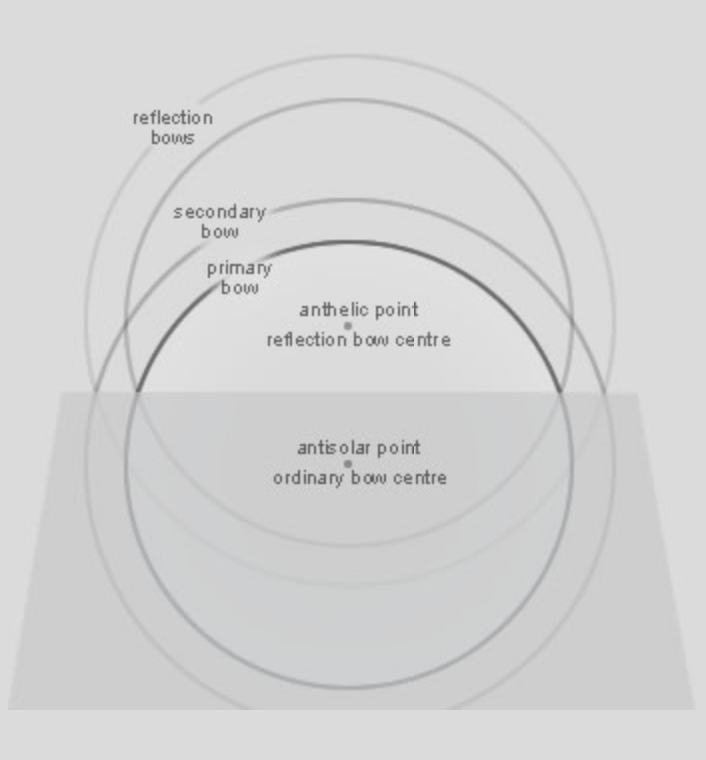

View at EarthSky Community Photos. | Earl Martin in Everett, Washington captured this image of a rare reflection rainbow over Puget Sound on May 5, 2020. Thanks for sharing, Earl!
When he captured this photo, Earl Martin wondered if he’d caught a triple rainbow. But what experts in atmospheric optics call tertiary or quaternary rainbows are exceedingly rare. Read the latest on them – from 2011 – here: First-ever photos of triple and quadruple rainbows
So the photo above isn’t a triple rainbow. But it’s still a rare kind of rainbow, rare enough to cause most people to do a double-take. Earl caught what’s called a reflection rainbow, which can be caused sunlight beaming upwards after reflecting from wet sand or calm water. In this case, the reflection rainbow is coming the water of Puget Sound in the Pacific Northwest, located along the northwestern coast of the U.S. state of Washington.
On his page of explanation for reflection rainbow, Les Cowley of the website Atmospheric Optics has the following diagram, showing exactly how reflection rainbows form.

Diagram by Les Cowley at Atmospheric Optics.
You can see in this diagram just what’s in Earl’s photo at top, a double rainbow (labeled primary and secondary bows in the diagram above), plus one reflection rainbow. Les wrote of the diagram:
The centers of reflection bows are at the same altitude as the sun – the anthelic point [point on the celestial sphere which lies directly opposite the sun from the observer]. This is the same distance above the horizon as the centers of normal bows are below it at the antisolar point.
The normal bow and its corresponding reflection bow intersect at the horizon.
Reflection bows are usually brightest when the sun is low because then its light is reflected most strongly from water surfaces. The normal and reflection bows draw closer together as the sun gets lower.
The source of the reflected light is usually water behind you, i.e. sunwards. It can be in front of you but then only the base of the reflected bow will be seen.
Thank you, Les, and thank you, Earl!
Bottom line: The photo shows what looks like an ordinary double rainbow with a third rainbow, at an odd angle, in their midst. The third rainbow is the reflection rainbow, reflected from the water in Puget Sound on May 5, 2020.
More: Another reflection rainbow photo, showing 4 rainbows this time, from 2015
from EarthSky https://ift.tt/3cHBzS7


View at EarthSky Community Photos. | Earl Martin in Everett, Washington captured this image of a rare reflection rainbow over Puget Sound on May 5, 2020. Thanks for sharing, Earl!
When he captured this photo, Earl Martin wondered if he’d caught a triple rainbow. But what experts in atmospheric optics call tertiary or quaternary rainbows are exceedingly rare. Read the latest on them – from 2011 – here: First-ever photos of triple and quadruple rainbows
So the photo above isn’t a triple rainbow. But it’s still a rare kind of rainbow, rare enough to cause most people to do a double-take. Earl caught what’s called a reflection rainbow, which can be caused sunlight beaming upwards after reflecting from wet sand or calm water. In this case, the reflection rainbow is coming the water of Puget Sound in the Pacific Northwest, located along the northwestern coast of the U.S. state of Washington.
On his page of explanation for reflection rainbow, Les Cowley of the website Atmospheric Optics has the following diagram, showing exactly how reflection rainbows form.

Diagram by Les Cowley at Atmospheric Optics.
You can see in this diagram just what’s in Earl’s photo at top, a double rainbow (labeled primary and secondary bows in the diagram above), plus one reflection rainbow. Les wrote of the diagram:
The centers of reflection bows are at the same altitude as the sun – the anthelic point [point on the celestial sphere which lies directly opposite the sun from the observer]. This is the same distance above the horizon as the centers of normal bows are below it at the antisolar point.
The normal bow and its corresponding reflection bow intersect at the horizon.
Reflection bows are usually brightest when the sun is low because then its light is reflected most strongly from water surfaces. The normal and reflection bows draw closer together as the sun gets lower.
The source of the reflected light is usually water behind you, i.e. sunwards. It can be in front of you but then only the base of the reflected bow will be seen.
Thank you, Les, and thank you, Earl!
Bottom line: The photo shows what looks like an ordinary double rainbow with a third rainbow, at an odd angle, in their midst. The third rainbow is the reflection rainbow, reflected from the water in Puget Sound on May 5, 2020.
More: Another reflection rainbow photo, showing 4 rainbows this time, from 2015
from EarthSky https://ift.tt/3cHBzS7

Aucun commentaire:
Enregistrer un commentaire